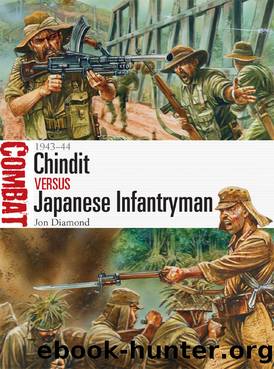Chindit vs. Japanese Infantryman by Jon Diamond

Author:Jon Diamond
Language: eng
Format: epub
Tags: Chindit versus Japanese Infantryman
ISBN: 9781472806536
Publisher: Osprey Publishing
A Chindit on a stretcher receives plasma at Broadway on 6 March 1944. He was one of the many casualties of the previous night’s glider crashes, owing to furrows in the landing field. Out of Calvert’s 542 men that landed by glider, 24 had been killed and 30 badly wounded. It is quite evident that Wingate’s new paradigm for Operation Thursday was intended to address more pro-active medical care of the wounded in the field as well as construction of light-aircraft strips for rapid evacuation of serious cases to rear-echelon hospitals. The despondency that overtook the surviving Chindits after Operation Longcloth, with respect to leaving the seriously wounded or non-ambulatory troops behind, was to be avoided during this mission. The Chindit standing over the stretcher has a 9mm Sten submachine gun slung over his right shoulder. Featuring a 32-round detachable box magazine and capable of producing a cyclic rate of fire of 500 rounds per minute, it was relatively light at 6.5lb and had an overall length of 30in. Its range was limited, though, to 230ft and it had a bad tendency when used in the jungle either to jam or to fire off uncontrollably. (NARA RG-208-AA-221-50653-AC)
On 5–6 March 1944 Brig Michael Calvert’s 77th Indian Infantry Brigade was inserted into the Kaukkwe Valley north-east of Katha to establish a ‘stronghold’ designated Broadway. In order to disrupt the Indaw–Myitkyina railway and motor-road traffic supplying 18th Division (now commanded by Lieutenant-General Tanaka Shinichi) in the Hukawng and Mogaung valleys, Calvert led his force on an arduous trek, commencing on 9 March 1944, through the Kaukkwe Valley. The force was comprised of five columns from Broadway: two columns from 3rd Battalion, 6th Gurkha Rifles, under Lt-Col Hugh Skone (No. 36) and Maj Freddie Shaw (No. 63); two columns from 1st Battalion, The South Staffordshire Regiment, under Lt-Col G.P. Richards (No. 38) and Maj Ron Degg (No. 80); and one column (No. 25), led by Calvert himself, comprised of elements of 77th Indian Infantry Brigade including Capt Ian Macpherson’s Brigade HQ Defence Company, a Gurkha unit, which was Calvert’s personal assault company. Calvert’s mission was to establish a railway and road-block at Henu. As fit as the Chindits were, it would take Calvert’s force six days to traverse the jungles and coax their supply-laden mules over the Gangaw Range to the east of Henu.
Mutaguchi had no contingency plans for an Allied airborne invasion and he was going to use only whatever Japanese units were on hand in the area of the landings to oppose the Chindits. In the Henu area, Mutaguchi had: two companies of Japanese troops from a railway engineer battalion and assorted administrative troops at Henu village; three sections of a platoon (under 2nd Lieutenant Kiyomizu) from Major Takemura’s II/51st Infantry (15th Division); and two infantry companies formed from elements of III/114th Infantry (18th Division) and led by Lieutenant-Colonel Nagahashi Jiroku of Mutaguchi’s HQ staff, stationed in the area Mandalay–Maymyo; 500 rear-echelon troops garrisoned at Mawlu village and Mawlu Station; and 300 Japanese infantry from assorted units at Nansiaung, just north of Henu.
Download
This site does not store any files on its server. We only index and link to content provided by other sites. Please contact the content providers to delete copyright contents if any and email us, we'll remove relevant links or contents immediately.
Smithsonian Civil War by Smithsonian Institution(971)
Tiger I and Tiger II (Images of War) by Anthony Tucker-Jones(948)
Battle Cry of Freedom by James M. McPherson(898)
Deadliest Men by Kirchner Paul(776)
The Pacific War by Robert O'Neill(771)
Maps of War by Jeremy Black(747)
Flags of Our Fathers by James Bradley & Ron Powers(742)
D-Day, June 6, 1944: The Climactic Battle of World War II by Stephen E. Ambrose(699)
Third Reich Propaganda (The Third Reich From Original Sources) by Carruthers Bob(693)
Lewes and Evesham 1264-65 by Richard Brooks(662)
The Oxford Illustrated History of the First World War by Hew Strachan(632)
The French Army in the First World War by Ian Sumner(626)
Frames of War by Judith Butler(571)
Early Samurai AD 200-1500 by Anthony J Bryant(560)
American Amphibious Gunboats in World War II by Robin L. Rielly(538)
Battle Cry of Freedom: The Civil War Era (Oxford History of the United States) by McPherson James M(537)
Kursk 1943 by Robert Forczyk(513)
The Civil War by Geoffrey C. Ward(511)
The Nazis – A Warning from History by Laurence Rees(511)
